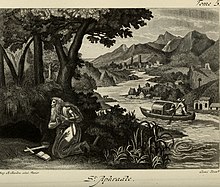Aphrahat the Persian | |
|---|---|
 Aphrahat depicted in Les Vies des Pères des déserts d'Orient : leur doctrine spirituelle et leur discipline monastique (1886) | |
| Church Father Bishop, Abbot | |
| Born | c. 280[1] Erbil, Sassanian empire |
| Died | c. 345 Erbil, Sassanian empire |
| Venerated in | Catholic Church Eastern Orthodox Church Oriental Orthodox Church Church of the East |
| Canonized | Pre-congregation |
| Major shrine | Mar Mattai Monastery |
| Feast | 29 January (Roman Catholic, Eastern Orthodox, Oriental Orthodox) 20 Tobi (Coptic Orthodox) |
| Attributes | Shemagh, habit |
| Patronage | Erbil, Mosul |
Aphrahat (c. 280–c. 345; Syriac: ܐܦܪܗܛ, Ap̄rahaṭ ,Persian: فرهاد, Arabic: أفراهاط الحكيم, Ancient Greek: Ἀφραάτης, and Latin Aphraates), venerated as Saint Aphrahat the Persian, was a third-century Syriac Christian author of Iranian descent from the Sasanian Empire, who composed a series of twenty-three expositions or homilies on points of Christian doctrine and practice.[2] All his known works, the Demonstrations, come from later on in his life. He was an ascetic and celibate, and was almost definitely a son of the covenant (an early Syriac form of communal monasticism). He may have been a bishop, and later Syriac tradition places him at the head of Mar Mattai Monastery near Mosul in what is now northern Iraq.[3] He was a near contemporary to the slightly younger Ephrem the Syrian, but the latter lived within the sphere of the Roman Empire. Called the Persian Sage (Syriac: ܚܟܝܡܐ ܦܪܣܝܐ, Ḥakkimā Pārsāyā), Aphrahat witnessed to the concerns of the early church beyond the eastern boundaries of the Roman Empire.
- ^ Cite error: The named reference
Dukhranawas invoked but never defined (see the help page). - ^ One or more of the preceding sentences incorporates text from a publication now in the public domain: McLean, Norman (1911). "Aphraates". In Chisholm, Hugh (ed.). Encyclopædia Britannica. Vol. 2 (11th ed.). Cambridge University Press. pp. 165–166.
- ^ McLean 1911, p. 165.